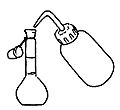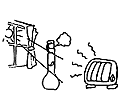Quantitation Error Factors in Sample Preparation
The processes involved in analysis by HPLC can be categorized as sample preparation, injection, separation, detection, and data processing. Factors that can affect quantitation error are present in all of these stages, but here we focus on factors in the sample preparation stage.
Preparing Standard Solutions
The tendency is to think of things too simplistically, but there are many factors to consider, such as those in Table 1, for example.
Of these, one of the most important factors is (K) Adsorption of Target Components to the Container. In the example shown in Table 2, in some cases adsorption can be suppressed by selecting a different solvent or changing the container material. Adsorption is also discovered by not being able to achieve calibration curve linearity (or the line does not pass through the origin) when the solution is diluted.
Another important factor is (N) Oxidation or Decomposition of Target Components. For example, since ascorbic acid is easily oxidized by dissolved oxygen or iron(III) ions in an aqueous solution, its concentration decreases over time. If this occurs, we recommend reducing the pH level or masking the iron ions with EDTA or 2Na and injecting the sample promptly after preparation. In general, to inhibit oxidation and decomposition, a reducing agent is added, the atmosphere is purged with nitrogen, a nonaqueous solvent is used, a brown bottle is used, and/or the solution is stored in a cool dark location. Oxidation and decomposition are also discovered due to reduced area values when sample solutions are injected multiple times.
Operations |
1) Measure the weight of the standard substance  |
2) Add solvent to make a solution  |
3) Save the solution  |
| Items That Cause Error Factors | (A) Inadequate measurement precision (B) Operator error during measurement (C) Impurities (D) Unconfirmed hydrates (E) hygroscopicity |
(F) Inadequate apparatus precision (G) Operator error filling to volume (H) Operator error diluting (I) Inadequate dissolution (considering temperature changes as well) (J) Solution nonhomogeneity (K) Adsorption of target components to the container (L) Introduction of target components from the container or atmosphere (relatively special cases) |
(M) Solvent evaporation (N) Oxidation/decomposition of target components |
| Material | Examples of Easily Adsorbed Components | Solvents for Inhibiting Adsorption |
| Glass | Cations (quaternary ammonium and metal ions) Amines - Depends on hydrogen bond of nitrogen lone pair electrons |
• Reduce pH • Add perchlorate ions • Add competing ions |
| Metals | Anions Chelating components (alpha-hydroxy acids, beta-diketones, and tropolones) |
• Add competing ions • Reduce pH (or increase, in some cases) • Add a metal masking agent |
| Synthetic Polymers | Highly hydrophobic components | • Reduce polarity |
Pretreating Samples
This operation involves additional problems with extraction and recovery rates. In some cases, high recovery rates cannot be achieved or recovery rates do not stabilize during processes such as solid-liquid extraction (including a pretreatment column) or liquid-liquid extraction. During deproteinization operations as well, target components can adsorb to denatured proteins and reduce the recovery rate.
Normally, recovery rates are evaluated by adding and extracting target components to/from samples. In other words, it investigates how the relationship between the amount of target components added and the increase in peak areas within a chromatogram changes in comparison to results obtained when the target component solution is injected directly without extraction operations.
If there is a problem with recovery rates, the extraction method should be changed, or components should be extracted after adding an internal standard substance. In this case, the internal standard substance must have a similar chemical structure to target components and about the same extraction efficiency (refer to LCtalk vol. 25, p. 5). This pretreatment method is often used when the recovery rate is relatively stable, even if not 100 %.
To ensure good analytical precision, routinely think about what factors that affect error levels require special attention in your own analytical work and whether there are any problems occurring.
(Y.Eg)








